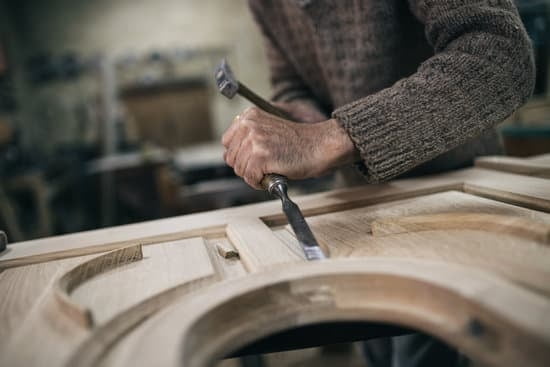Are you a woodworking enthusiast looking for the best software to bring your designs to life? In this article, we will compare and contrast two popular modeling programs, Fusion 360 and Sketchup, to help you decide which one is the right fit for your woodworking projects.
For those in the woodworking community, the debate over which software is better suited for their needs has been ongoing. Fusion 360 and Sketchup are both powerful tools that offer a wide range of features specifically tailored for woodworking projects. Understanding the strengths and weaknesses of each program will help you make an informed decision.
Fusion 360, developed by Autodesk, is a cloud-based CAD/CAM tool with advanced modeling capabilities. On the other hand, Sketchup, developed by Trimble Inc. is known for its user-friendly interface and ease of use.
Both programs have distinct features and tools that cater to woodworkers’ specific needs, making them popular choices in the industry. In this article, we will delve into the key features and tools of Fusion 360 and Sketchup for woodworking, as well as compare their user interface, modeling capabilities, compatibility with woodworking machinery and 3D printing, cost options, and more.
Key Features and Tools in Fusion 360 for Woodworking
Fusion 360 is a powerful 3D CAD, CAM, and CAE software that is widely used in the woodworking industry. It offers a range of key features and tools specifically designed for woodworking projects. Some of these features include:
- Parametric modeling: Fusion 360 allows woodworkers to create precise and customizable 3D models of their woodworking projects. The parametric modeling feature enables users to easily modify dimensions, shapes, and other design elements.
- Design history: This feature enables users to track and make changes to their design process, allowing for greater flexibility and control over the entire woodworking project.
- Simulation and analysis tools: Fusion 360 offers simulation tools that allow woodworkers to test the strength, durability, and performance of their designs before actually building them.
In addition to these key features, Fusion 360 also provides a comprehensive set of tools tailored for woodworking:
- Woodworking joints: Fusion 360 comes with a wide range of pre-built woodworking joints such as dovetail joints, dado joints, box joints, and more. These can be easily incorporated into designs for seamless construction.
- Integrated CAM functionality: The software offers integrated computer-aided manufacturing (CAM) functionality, allowing woodworkers to generate toolpaths for CNC machining directly from their designs.
- Real-time collaboration: Fusion 360 allows users to work collaboratively on woodworking projects in real-time, facilitating seamless communication among team members or clients.
Overall, Fusion 360 provides an extensive suite of tools and features that cater specifically to the needs of woodworkers looking to design and manufacture high-quality woodworking projects.
The keyword “fusion 360 vs sketchup for woodworking” is essential when considering the capabilities of both software options. While Sketchup has its own strengths in various areas such as ease of use and community support which we will discuss later on in this article, it’s clear that Fusion 360 holds its own particularly when it comes to the depth of features available for advanced woodworking projects.
Key Features and Tools in Sketchup for Woodworking
SketchUp is a popular 3D modeling software known for its user-friendly interface and ease of use. It offers a range of features and tools specifically designed to cater to woodworking projects. One of the key features in SketchUp for woodworking is its robust library of 3D models, textures, and materials that are essential for creating detailed woodworking designs. These components can be easily accessed and incorporated into your woodworking projects, saving time and effort in the design process.
In addition to its extensive library, SketchUp’s push-pull tool allows woodworkers to easily manipulate shapes and create accurate 3D models of their woodworking designs. This tool enables users to extrude or indent surfaces with precision, making it an essential feature for creating detailed woodworking plans. Furthermore, SketchUp also offers a range of measurement tools that allow woodworkers to ensure accuracy in their designs, making it easier to plan cuts and joinery.
Moreover, SketchUp provides a platform for woodworking enthusiasts to collaborate with other designers and professionals in the field. Its sharing capabilities allow users to share their woodworking projects with others, gather feedback, and even work on projects together through cloud-based collaboration. This feature can be particularly beneficial for woodworkers who are part of a team or those seeking input from experienced professionals in the industry.
Overall, SketchUp offers an array of features and tools specifically tailored for woodworking projects. Its user-friendly interface, extensive library of resources, precision tools, and collaborative capabilities make it a strong contender when compared with Fusion 360 for woodworking projects.
| Key Features | Sketchup |
|---|---|
| User-Friendly Interface | Yes |
| Extensive Library | Yes |
| Precision Tools | Yes |
User Interface and Ease of Use Comparison
When it comes to woodworking, the user interface and ease of use are important considerations when choosing between Fusion 360 and Sketchup. Both software options offer unique features and tools that cater to different skill levels and preferences, making it essential to understand the differences in their user interfaces.
Fusion 360 User Interface
Fusion 360 offers a comprehensive yet intuitive user interface that is designed to be user-friendly for both beginners and advanced users. The software provides a clean workspace with customizable toolbars, allowing woodworkers to have easy access to commonly used tools for their projects. Fusion 360 also offers a seamless transition between 2D sketching and 3D modeling, making it convenient for woodworking projects that require both types of design.
Sketchup User Interface
In contrast, Sketchup is known for its simple and straightforward user interface, making it a popular choice for beginner woodworkers. The toolbar in Sketchup is easy to navigate, with basic tools such as push and pull, move, rotate, and scale readily accessible. This simplicity in the interface can be appealing to users who prefer a more minimalist approach to design software.
Ease of Use Comparison
When comparing the ease of use between Fusion 360 and Sketchup for woodworking, it ultimately comes down to personal preference and familiarity with similar software. Fusion 360 may be preferred by those who are accustomed to parametric modeling or require advanced functionality such as simulation or animation. On the other hand, Sketchup’s simplicity may be ideal for hobbyist woodworkers or those who prioritize a quick learning curve.
Overall, both Fusion 360 and Sketchup offer unique user interfaces that cater to different woodworking needs. While Fusion 360 may appeal to those seeking advanced functionality and a seamless integration between 2D sketching and 3D modeling, Sketchup’s straightforward interface may be more suitable for beginners or those looking for a simpler approach to woodworking design.
Modeling Capabilities and Advanced Functionality
When it comes to modeling capabilities and advanced functionality, both Fusion 360 and Sketchup have their strengths in meeting the needs of woodworking enthusiasts and professionals.
Fusion 360 is known for its parametric modeling, which allows users to easily make changes to their designs while maintaining relationships between different parts of the model. This can be particularly useful for woodworking projects that require precise measurements and intricate details. Additionally, Fusion 360 offers advanced simulation tools that allow users to test their designs under real-world conditions, ensuring that the final product will meet quality standards.
On the other hand, Sketchup is praised for its intuitive and user-friendly interface, making it a popular choice for beginners in woodworking. Its robust selection of plugins and extensions also provides users with a wide range of tools and features to enhance their modeling capabilities. While Sketchup may not offer the same level of advanced functionality as Fusion 360, it is more than capable of meeting the needs of many woodworking projects.
In terms of advanced functionality, Fusion 360’s parametric modeling and simulation tools give it an edge over Sketchup. However, Sketchup’s user-friendly interface and extensive plugin library make it a strong contender in this aspect as well. Ultimately, the choice between Fusion 360 vs Sketchup for woodworking depends on the specific needs and preferences of the user.
| Modeling Capabilities and Advanced Functionality | Comparison |
|---|---|
| Fusion 360 | Parametric modeling Advanced simulation tools |
| Sketchup | User-friendly interface Wide range of plugins and extensions |
Compatibility With Woodworking Machinery and 3D Printing
When it comes to woodworking, compatibility with machinery and 3D printing is a crucial aspect to consider when choosing between Fusion 360 and Sketchup. Both software offer different levels of compatibility with woodworking machinery and 3D printing, which can greatly impact the workflow and efficiency of woodworkers.
Fusion 360 Compatibility
Fusion 360 is known for its seamless integration with CNC machines, which are essential for creating precision-cut wood pieces. Its CAM (Computer-Aided Manufacturing) functionality allows users to generate toolpaths directly from their 3D models, making it easier to translate designs into physical objects. Additionally, Fusion 360 supports various file formats commonly used in the woodworking industry, such as DWG and DXF, which enables smooth communication with other software and machinery.
Sketchup Compatibility
While Sketchup also offers some level of compatibility with CNC machines through third-party plugins, it may not be as advanced or streamlined as Fusion 360. Users may need to rely on external software or converters to prepare their Sketchup models for manufacturing processes. However, Sketchup’s simplicity and flexibility make it a popular choice for creating basic designs that can be easily exported for woodworking machinery.
Overall, Fusion 360’s native support for CAM operations and file formats gives it an edge over Sketchup in terms of compatibility with woodworking machinery and 3D printing. Woodworkers who prioritize seamless integration with manufacturing processes may find Fusion 360 more suitable for their needs.
Cost and Subscription Options
When it comes to choosing a software for woodworking, cost and subscription options play a crucial role in the decision-making process. Both Fusion 360 and Sketchup offer different pricing models that cater to the needs of woodworkers, whether they are professionals or hobbyists.
Fusion 360 offers a flexible subscription model, where users can choose between monthly, yearly, or even triennial subscriptions. This provides woodworkers with the option to pay for the software based on their project needs and financial situation. Additionally, Fusion 360 offers a free personal use version for non-commercial use, making it an attractive option for hobbyists who want to explore the software before committing to a subscription.
On the other hand, Sketchup offers a similar subscription model with both monthly and annual plans available. One unique feature of Sketchup is the option to purchase a “Classic” perpetual license, which allows users to own the software outright with no expiration date. This can be beneficial for woodworkers who prefer a one-time investment rather than ongoing subscription fees.
In summary, both Fusion 360 and Sketchup offer cost-effective options for woodworkers at different stages of their careers. The key is to evaluate your project needs and budget constraints before making a decision on which software best fits your woodworking requirements.
- Fusion 360 offers monthly, yearly, or triennial subscriptions
- Fusion 360 has a free personal use version for non-commercial use
- Sketchup offers both monthly and annual plans
- Sketchup also has a “Classic” perpetual license option
Case Studies and Examples of Woodworking Projects Created With Fusion 360 and Sketchup
When it comes to woodworking, both Fusion 360 and Sketchup have been used to create stunning projects that showcase the capabilities of these design software. One notable case study is the creation of a custom-designed furniture piece using Fusion 360.
The software’s parametric modeling tools allowed the woodworker to easily modify dimensions and make adjustments to the design, ensuring a perfect fit for the client’s space. Additionally, Fusion 360’s simulation and rendering features provided a realistic preview of the final product, enabling the woodworker to make informed decisions about materials and finishes.
On the other hand, Sketchup has also been utilized in woodworking projects such as creating intricate joinery for custom cabinets. The software’s intuitive interface and extensive library of plugins made it easy for woodworkers to visualize complex joints and connections, ensuring precision in their designs. Furthermore, Sketchup’s compatibility with CNC machines allowed for seamless integration with woodworking machinery, streamlining the manufacturing process for intricate and detailed pieces.
Another example is the construction of a wooden deck using both Fusion 360 and Sketchup. While Fusion 360 was used for precise measurements and structural analysis, Sketchup was leveraged for its array of textures and materials to provide a realistic visualization of the finished product. This combination allowed for a holistic approach to design and planning, resulting in a well-executed woodworking project.
Conclusion
In conclusion, both Fusion 360 and Sketchup have their unique advantages and drawbacks when it comes to woodworking. Fusion 360 offers a wide range of advanced features and tools that make it a powerful option for professional woodworkers. Its parametric modeling, simulation capabilities, and compatibility with CNC machinery and 3D printing make it an excellent choice for those looking for a comprehensive solution.
On the other hand, Sketchup is known for its user-friendly interface and ease of use, making it a great option for hobbyists and beginners in the woodworking field. It also has a large community of users and an extensive library of plugins and extensions that can enhance its functionality for woodworking projects.
Ultimately, the decision between Fusion 360 vs Sketchup for woodworking will depend on the specific needs and preferences of the user. Those who require advanced modeling capabilities and integration with manufacturing processes may find Fusion 360 to be the better option. Meanwhile, those who prioritize simplicity and accessibility may prefer Sketchup for their woodworking projects.
Regardless of the choice made, both software options have been used successfully by woodworkers to create stunning designs and functional pieces. It’s important to consider the specific requirements of each project before making a decision between Fusion 360 vs Sketchup for woodworking.
Frequently Asked Questions
Which Is Better for Woodworking Fusion 360 or SketchUp?
Both Fusion 360 and SketchUp have their advantages for woodworking. Fusion 360’s parametric modeling capabilities make it great for precise designs, while SketchUp’s ease of use and extensive library of plugins can be beneficial.
Is Fusion 360 Good for Woodworking?
Fusion 360 is a powerful tool for woodworking due to its ability to create detailed and accurate 3D models. It also offers features like parametric modeling and simulation that can be incredibly useful for woodworkers.
Is SketchUp Good for Woodworkers?
SketchUp is a popular choice among woodworkers because of its user-friendly interface and extensive library of extensions. It allows woodworkers to quickly create and visualize their designs in 3D, making it a valuable tool for the woodworking community.

Hi everyone! I’m a woodworker and blogger, and this is my woodworking blog. In my blog, I share tips and tricks for woodworkers of all skill levels, as well as project ideas that you can try yourself.





